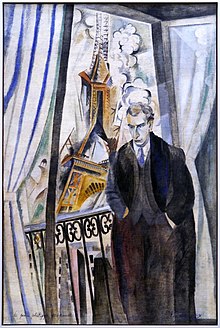Robert Delaunay
Appearance

Robert Delaunay (12 April 1885 – 25 October 1941) was a French artist. He was one of the Orphist school of painters, who combined Cubism and abstraction.
Quotes
[edit]



1910s
[edit]- What they are saying is okay [the Futurist artists like Severini, Carra and Russolo, who debated in Paris intensively with the Cubist artists].
- letter, February 1912; as cited in Futurism, ed. by Didier Ottinger; Centre Pompidou / 5 Continents Editions, Milan, 2008, p. 184
- 'Simultaneousness' is a technique. Simultaneous contrast is the most up-to-date honey of this technique in this field. Simultaneous contrast is visible depth – Reality, Form, construction, representation. Depth is the new inspiration. We live in depth, we travel in depth. I’m in it. The senses are in it. And the mind is too.
- Simultanism, October 1913; as cited in Futurism, ed. by Didier Ottinger; Centre Pompidou / 5 Continents Editions, Milan, 2008, p. 57
- The need for a new subject has inspired the poets, launching them onto a fresh path and bringing to their attention to poetry of la Tour [the Eiffel tower in Paris], which communicates mysteriously with the whole world. Rays of light, waves of symphonic sounds. Factories, bridges, iron structures, airships, the numberless gyrations of aeroplanes, windows seen by crowd simultaneously.
- Les Soirées de Paris; republished in 'Sturm' [German art-magazine edited by Walden]; as cited in a document, published by Francastel op. cit. October 1913 11 bis p. 111
- On the other hand, the artist has much to do in the realm of color construction, which is so little explored and so obscure, and hardly dates back any farther than to the beginning of Impressionism.
- Herschel Browning Chipp Theories of Modern Art: A Source Book by Artists and Critics, University of California Press, 1968, p. 318
- As long as art cannot get free from the object, it will continue to be a description.
- On light; as quoted in: Susanna Partsch, Paul Klee (2003) Klee. p. 20
- I can see the black spots of the sun [remark to Sonia Delaunay, his wife and female artist].
- Nous irons jusqu'au soleil, Delaunay; as cited in: 'Futurism', ed. By Didier Ottinger; Centre Pompidou / 5 Continents Editions, Milan, 2008, p. 214
- Light in nature creates movement in color. The movement is provided by the relationships of uneven measures, of colors contrasts among themselves and constitutes Reality [In this quote Delaunay is referring to his series 'Window'-paintings', which he had started in 1912].
- Nous irons jusqu'au soleil, Delaunay; as cited in 'Futurism', ed. By Didier Ottinger; Centre Pompidou / 5 Continents Editions, Milan, 2008, p. 217
1920s
[edit]- The woman of City of Paris' [Delaunay painted in 1910 – 1912] sums up the [his] Cubist period.. ..'The Cardiff team' [he painted in 1913] is more significant in the expression of colour, less shattered. The yellow poster in the complete picture contrasts with the blues, greens and orange.
- Du cubisme a l'art abstrait; published by Francastel in 1924; Quoted in Futurism, ed. By Didier Ottinger; Centre Pompidou / 5 Continents Editions, Milan, 2008, p. 190
1930s
[edit]- This happened in 1912. Cubism was in full force. I made paintings that seemed like prisms compared to the Cubism my fellow artists were producing. I was the heretic of Cubism. I had great arguments with my comrades who banned color from their palette, depriving it of all elemental mobility. I was accused of returning to Impressionism, of making decorative paintings, etc.. .I felt I had almost reached my goal.[6]
- First Notebook, 1939, as cited in The New Art of Color: The Writings of Robert and Sonia Delaunay, Viking Press, 1978; as quoted on Wikipedia / Delaunay
Quotes about Robert Delaunay
[edit]- Robert wanted to look straight at the midday sun, the absolute disk.. ..he closed his eyelids and focused in his retinal reactions. Back home, what he tried to commit to canvas was what he had seen with his eyes open and his eyes shut.
- Sonia Delaunay, in Nous irons jusqu'au soleil, Delaunay; as cited n Futurism, ed. Didier Ottinger; Centre Pompidou / 5 Continents Editions, Milan, 2008, p. 214
- his wife Sonia Delaunay refers to the paintings which Robert Delaunay made in the Summer of 1913.
- Never had the critics been so violent as they were at that time. From which it became clear that these paintings - and I specify the names of the painters who were, alone, the reluctant causes of all this frenzy: Jean Metzinger, Le Fauconnier, Fernand Léger, Robert Delaunay and myself - appeared as a threat to an order that everyone thought had been established forever.
- Albert Gleizes, The Epic, From immobile form to mobile form (1925)
- He [Robert Delaunay] gives movement itself [in his pictures], the Futurists only illustrate movement..
- August Macke, c. 1913; as cited by de:Wolf-Dieter Dube, in Expressionism; Praeger Publishers, New York, 1973, p. 145
- Macke visited Delaunay in 1912, in Paris, and Robert Delanuay came to Macke in Bonn, 1913
- It used to be said of a woman: why she's a Velázquez infanta! Now it is said: she's a Renoir blonde! I have no doubt that, in the future, it will be proclaimed: she's as exuberant as a Delaunay, as noble as a Le Fauconnier, as beautiful as a Georges Braque or Picasso.
- Jean Metzinger, in Note sur la Peinture (1910)


